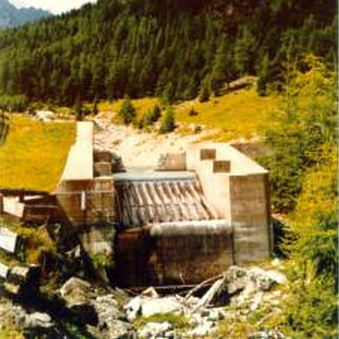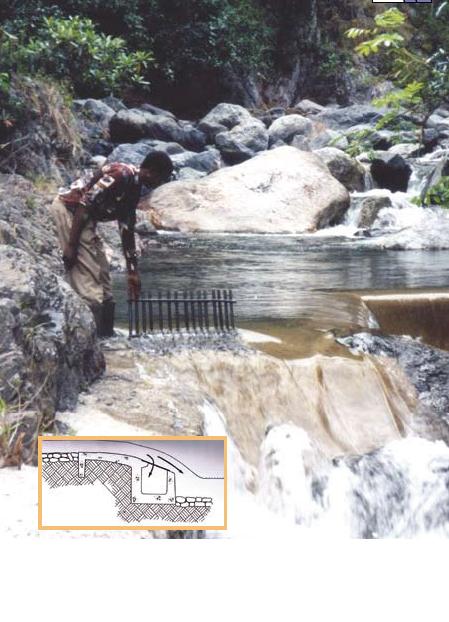वाटर पोर्टल / वर्षाजल संचयन / सतही जल / टाइरोलीन मेड़
| |
|
|
|
|
|
|
|
|
टाइरोलीन मेड़ एक प्रवेश संरचना है, जिसमें गटर के ऊपर एक जाली लगा कर पानी को मुख्य प्रवाह से निकाला जाता है. गटर आमतौर पर कंक्रीट से बनी होती हैं और इसे नदी तल में बनाया जाता है. जाली सबसे ऊपरी हिस्से पर (15-30 डिग्री) नीचे की तरफ के ढलान पर बनायी जाती हैं, जिससे प्रवाह वेग में वृद्धि हो और धारा के साथ आने वाले तलछट जो जाम कर सकते हैं को रोका जा सके. गटर से, पानी एक एक पाइप लाइन में प्रवेश करती है, जो अवसादन टंकियों में और उसके बाद गुरुत्वाकर्षण के जरिये सिस्टम के बाकी हिस्सों में बहती है.
तटबंधों में बांधों और जल प्रवेश संरचनाएं कमजोर होती हैं और यह नदी से सिंचित जल व्यवस्था के लिए काफी महंगी होती हैं. वे आसानी से बाढ़, कम बहाव, रिसाव से क्षतिग्रस्त हो जाती हैं और तलछट जमा होने या पानी में कचरा जमा होने से ठप पड़ जाती हैं. टाइरोलीन मेड़ एक अधिक विश्वसनीय और सस्ता विकल्प तैयार करता है.
Contents
उपयुक्त परिस्थितियां
टाइरोलीन वाहिनियां छोटी स्थायी नदियों और धाराओं में कारगर साबित होती हैं, जहां तलछट और बहाव के साथ बहने वाली सामग्रियां कम होती हैं या बांध के शीर्ष से गिरती हैं.
मेड़ या सेवन के लिए स्थल चयन ध्यान से किया जाना चाहिए.
मेड़ खुद ही पानी को साफ या शुद्ध नहीं करता है.
| लाभ | हानि |
|---|---|
| - नदी के तटबंधों में बांधों और पानी प्रवेश संरचनाओं की तुलना में सस्ता अधिक विश्वसनीय. - ये निचली बहाव के पास रहने वाले समुदायों को प्रभावित नहीं करती हैं. |
- ज्ञात नहीं |
पर्यावरण परिवर्तन की स्थिति के लिए लचीलापन
सीमेंट पर सूखे का प्रभाव
सूखे का प्रभाव : बुरी तरह निर्मित कंकरीट या दरारें (जैसे, टैंक, बांधों, जलमार्ग, कुओं और अन्य संरचनाओं में).
प्रभाव के अंतर्निहित कारण : कम पानी का इस्तेमाल; मिश्रण में अशुद्ध पानी का प्रयोग.
वाश प्रणाली के लचीलेपन को बढ़ाने के लिए : पर्याप्त मिश्रण, अनुपात, सामग्री की शुद्धता सुनिश्चित करें; मिश्रण में पानी की मात्रा को कम करें; ठीक से सुखायें.
सूखे के प्रबंधन पर अधिक जानकारी: सूखा प्रभावित क्षेत्रों में लचीला वॉश सिस्टम..
Construction, operations and maintenance

A Tyrolean weir can either consist of parallel rods or a perforated plate, installed in the flow direction over the width of the stream with a 15-30 degree downward slope. Large stones, branches and large leaves cannot pass between the rods, and are prevented from entering the gutter. Because the rods / plate slopes downward, the material in the stream is pushed downstream, until it drops over the end of the weir.
The threshold can be a concrete elevation above the rocky bed of a mountain stream, or a vertical low weir structure, anchored in the embankment. The capacity of the inlet pipe / drain (diameter and gradient) should be 30% more than the design flow and have an uniform gradient to prevent accumulation of sand. The sedimentation tank can accumulate 1.5-2 m3 of deposits and allows water to filter for 10 to 30 minutes at very low speed. It is cleaned by washing it out.
Maintenance
Several visits per year to the site are necessary for inspection, cleaning and minor repairs. Overall, maintenance is easy to carry out due to low-tech structure and the use of local labour and materials.
Regular inspection and cleaning of the grit / rack and possibly the gutter and sedimentation tank is required during and after storm periods.
Costs
- Material (excluding the pipe and sedimentation tank): US$ 300 - 600.
- Labour (if site is easily accessible): 30 - 50 man days.
Manuals, videos and links
- Surface water intake and small dams. Chapter 11. Revised by Nhamo Masanganise.
Acknowledgements
- CARE Nederland, Desk Study: Resilient WASH systems in drought-prone areas. October 2010.

